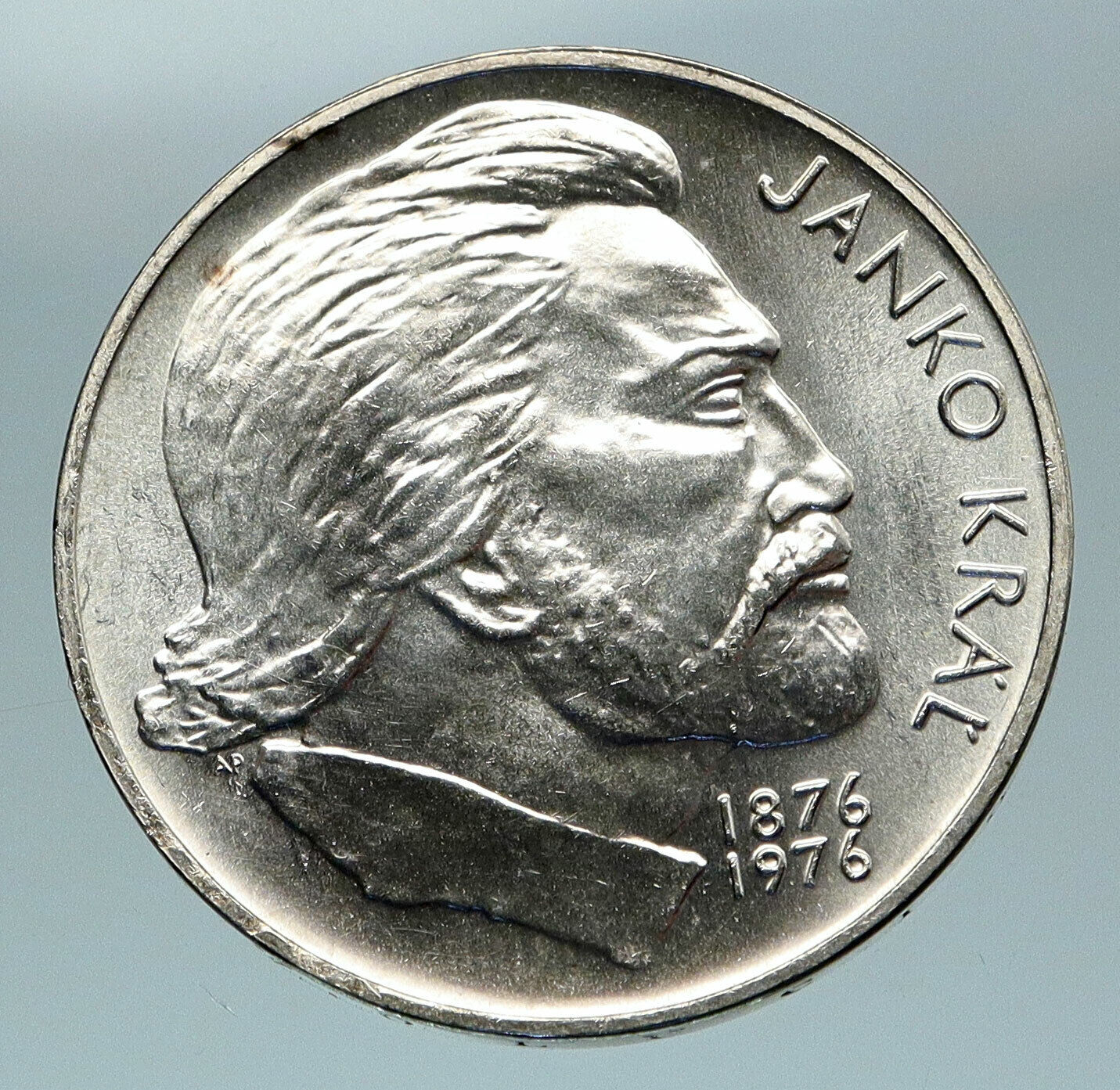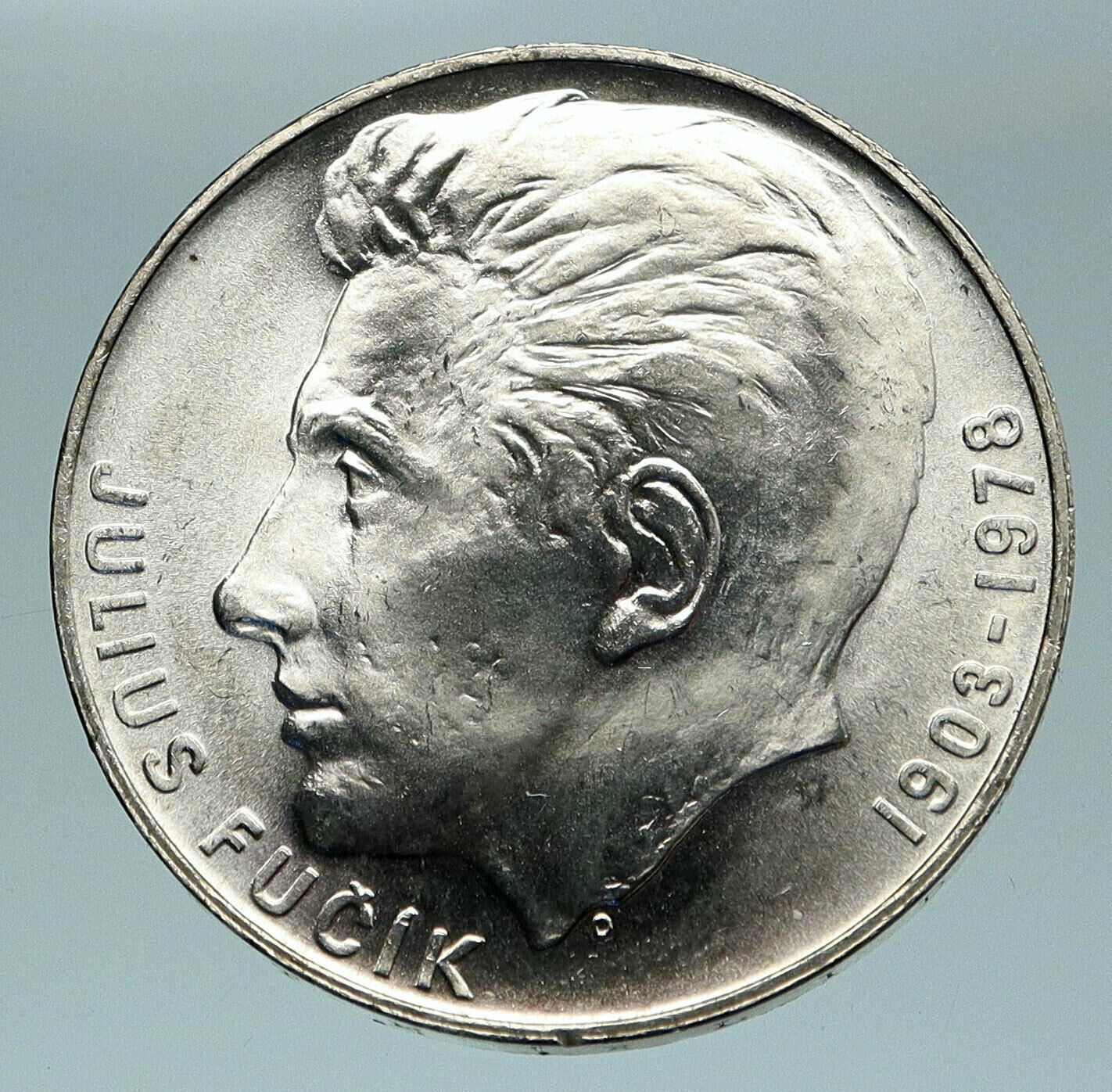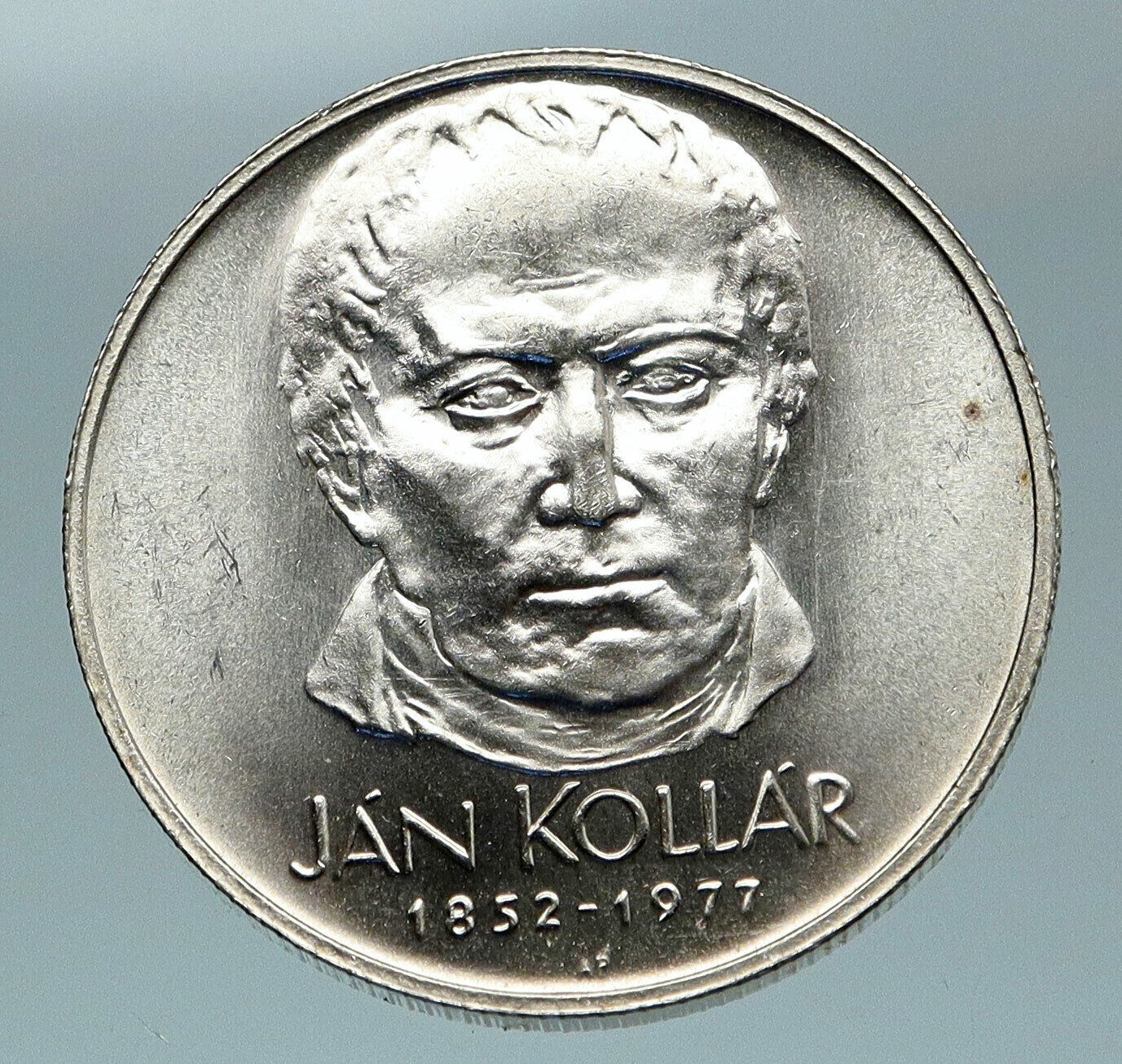|
Czech Republic – Czechoslovakia
50th Anniversary – Slovak National Theater
1970 Silver 25 Korun 30mm (10.00 grams) 0.500 Silver (0.1608 oz. ASW)
Reference: KM# 68 | Engraver: Zdeněk Kolářský, Ivan Stmad
ČESKOSLOVENSKÁ SOCIALISTICKÁ REPUBLIKA 25, Czech lion with socialist shield.
1920 NÁRODNÉ SLOVENSKÉ DIVADLO V BRATISLAVĚ 1970, Stylized head of muse.
Edge:
Diamonds and ovals.
You are bidding on the exact item pictured, provided with a Certificate of Authenticity and Lifetime Guarantee of Authenticity.
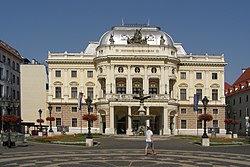 The Slovak National Theater (Slovak: Slovenské národné divadlo, abbr. SND) is the oldest professional theatre in Slovakia, consisting of three ensembles: opera, ballet, and drama. Its history begins shortly after the establishment of the first Czechoslovak Republic in 1918. It is located in the capital, Bratislava. The theatre is currently based in two separate buildings: the historic Neo-Renaissance building at Gorkého 2 (Hviezdoslavovo námestie) and the new SND building in the Old Town, opened on 14 April 2007, at Pribinova 17. Performances take place on most days of the year. The Slovak National Theatre has represented Slovak culture on its numerous tours abroad. The Slovak National Theater (Slovak: Slovenské národné divadlo, abbr. SND) is the oldest professional theatre in Slovakia, consisting of three ensembles: opera, ballet, and drama. Its history begins shortly after the establishment of the first Czechoslovak Republic in 1918. It is located in the capital, Bratislava. The theatre is currently based in two separate buildings: the historic Neo-Renaissance building at Gorkého 2 (Hviezdoslavovo námestie) and the new SND building in the Old Town, opened on 14 April 2007, at Pribinova 17. Performances take place on most days of the year. The Slovak National Theatre has represented Slovak culture on its numerous tours abroad.
After the establishment of the Czechoslovak Republic, the idea of a professional Slovak theatre slowly began to materialize. In 1919, the SND Cooperative commissioned the establishment of the Slovak National Theatre (SNT). The cooperative concluded a contract with the director of the East Bohemian Company, Bedřich Jeřábek. It was his opera and drama ensemble that in 1920 began operating all three SND ensembles (drama, opera, ballet) in the building of the former municipal theatre.
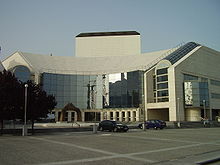 The opera of the SNT began its activities on 1 March 1920 with the production of The Kiss by Czech composer Bedřich Smetana. A day later, the drama ensemble presented the play Mariša by brothers Alois and Vilém Mrštík. The ballet section of the theatre made its debut with a production of Coppélia by Léo Delibes on 19 May 1920. The first performance in Slovak also took place in May of that year, with renditions of the one-act plays Hriech and V službe by Jozef Gregor-Tajovský. The opera of the SNT began its activities on 1 March 1920 with the production of The Kiss by Czech composer Bedřich Smetana. A day later, the drama ensemble presented the play Mariša by brothers Alois and Vilém Mrštík. The ballet section of the theatre made its debut with a production of Coppélia by Léo Delibes on 19 May 1920. The first performance in Slovak also took place in May of that year, with renditions of the one-act plays Hriech and V službe by Jozef Gregor-Tajovský.
The majority of the theatre’s original repertoire was performed in Czech because there were not enough Slovak plays, translations, actors, or singers. The first Slovak professional actors, Andrej Bagar, Janko Borodáč, Oľga Borodáčová, Jozef Kello, and Gašpar Arbét, formed the core of the SND promotional drama ensemble.
The SND ensembles originally played in three different buildings—the drama ensemble played in the Pavel Országh Hviezdoslav Theatre building on Laurinská Street and on the Small Stage of the Slovak National Theatre on Dostojevského rad. The opera and ballet were housed in a historic building on Hviezdoslav Square. On 14 April 2007, the SND moved to a new building on Pribinova Street no. 17, in which all three ensembles play under one roof. The space holds 1,700 seats. In addition to the new SND building, the theatre company also continues to use the historic building, where opera, ballet, and drama performances are still held.
 The e Czech Republic also known by its short-form name, Czechia, is a landlocked country in Central Europe bordered by Germany to the west, Austria to the south, Slovakia to the east and Poland to the northeast. The Czech Republic covers an area of 78,866 square kilometres (30,450 sq mi) with a mostly temperate continental climate and oceanic climate. It is a unitary parliamentary republic, with 10.6 million inhabitants; its capital and largest city is Prague, with 1.3 million residents. Other major cities are Brno, Ostrava, Olomouc and Pilsen. The Czech Republic is a member of the European Union (EU), NATO, the OECD, the United Nations, the OSCE, and the Council of Europe. The e Czech Republic also known by its short-form name, Czechia, is a landlocked country in Central Europe bordered by Germany to the west, Austria to the south, Slovakia to the east and Poland to the northeast. The Czech Republic covers an area of 78,866 square kilometres (30,450 sq mi) with a mostly temperate continental climate and oceanic climate. It is a unitary parliamentary republic, with 10.6 million inhabitants; its capital and largest city is Prague, with 1.3 million residents. Other major cities are Brno, Ostrava, Olomouc and Pilsen. The Czech Republic is a member of the European Union (EU), NATO, the OECD, the United Nations, the OSCE, and the Council of Europe.
It is a developed country with an advanced, high income export-oriented social market economy based in services, manufacturing and innovation. The UNDP ranks the country 14th in inequality-adjusted human development. The Czech Republic is a welfare state with a “continental” European social model, a universal health care system, tuition-free university education and is ranked 14th in the Human Capital Index. It ranks as the 6th safest or most peaceful country and is one of the most non-religious countries in the world, while achieving strong performance in democratic governance.
<img src="https://upload.wikimedia.org/wikipedia/commons/thumb/e/ed/Coat_of_arms_of_the_Czech_Republic.svg/85px-Coat_of_arms_of_the_Czech_Republic.svg.png" align="left" the="" czech="" republic="" includes="" historical="" territories="" of="" bohemia,="" moravia,="" and="" silesia.="" state="" was="" formed="" in="" late="" 9th="" century="" as="" duchy="" bohemia="" under="" great="" moravian="" empire.="" after="" fall="" empire="" 907,="" centre="" power="" transferred="" from="" moravia="" to="" přemyslid="" dynasty.="" 1002,="" formally="" recognized="" an="" imperial="" holy="" roman="" along="" with="" kingdom="" germany,="" burgundy,="" italy,="" numerous="" other="" territories,="" becoming="" 1198="" reaching="" its="" greatest="" territorial="" extent="" 14th="" century.="" beside="" itself,="" king="" ruled="" lands="" bohemian="" crown,="" holding="" a="" vote="" election="" emperor;="" prague="" seat="" periods="" between="" 17th="" hussite="" wars="" 15th="" driven="" by="" protestant="" reformation,="" faced="" economic="" embargoes="" defeated="" five="" consecutive="" crusades="" proclaimed="" leaders="" catholic="" church.=""
 Following the Battle of Mohács in 1526, the whole Crown of Bohemia was gradually integrated into the Habsburg Monarchy alongside the Archduchy of Austria and the Kingdom of Hungary. The Protestant Bohemian Revolt (1618-20) against the Catholic Habsburgs led to the Thirty Years’ War. After the Battle of the White Mountain, the Habsburgs consolidated their rule, eradicated Protestantism and reimposed Catholicism, and also adopted a policy of gradual Germanization. This contributed to the anti-Habsburg sentiment. A long history of resentment of the Catholic Church followed and still continues. With the dissolution of the Holy Roman Empire in 1806, the Bohemian Kingdom became part of the German Confederation 1815-1866 as part of Austrian Empire (1804 to 1867) and the Czech language experienced a revival as a consequence of widespread romantic nationalism. In the 19th century, the Czech lands became the industrial powerhouse of the monarchy and were subsequently the core of the Republic of Czechoslovakia, which was formed in 1918 following the collapse of the Austro-Hungarian Empire after World War I. Following the Battle of Mohács in 1526, the whole Crown of Bohemia was gradually integrated into the Habsburg Monarchy alongside the Archduchy of Austria and the Kingdom of Hungary. The Protestant Bohemian Revolt (1618-20) against the Catholic Habsburgs led to the Thirty Years’ War. After the Battle of the White Mountain, the Habsburgs consolidated their rule, eradicated Protestantism and reimposed Catholicism, and also adopted a policy of gradual Germanization. This contributed to the anti-Habsburg sentiment. A long history of resentment of the Catholic Church followed and still continues. With the dissolution of the Holy Roman Empire in 1806, the Bohemian Kingdom became part of the German Confederation 1815-1866 as part of Austrian Empire (1804 to 1867) and the Czech language experienced a revival as a consequence of widespread romantic nationalism. In the 19th century, the Czech lands became the industrial powerhouse of the monarchy and were subsequently the core of the Republic of Czechoslovakia, which was formed in 1918 following the collapse of the Austro-Hungarian Empire after World War I.
Czechoslovakia remained the only democracy in this part of Europe in the interwar period. However, the Czech part of Czechoslovakia was occupied by Germany in World War II, while the Slovak region became the Slovak Republic; Czechoslovakia was liberated in 1945 by the armies of the Soviet Union and the United States. Most of the three millions of the German-speaking minority were expelled following the war. The Communist Party of Czechoslovakia won the 1946 elections and after the 1948 coup d’état, Czechoslovakia became a one-party communist state under Soviet influence. In 1968, increasing dissatisfaction with the regime culminated in a reform movement known as the Prague Spring, which ended in a Soviet-led invasion. Czechoslovakia remained occupied until the 1989 Velvet Revolution, when the communist regime collapsed and market economy was reintroduced. On 1 January 1993, Czechoslovakia peacefully dissolved, with its constituent states becoming the independent states of the Czech Republic and Slovakia. The Czech Republic joined NATO in 1999 and the EU in 2004.
|





 The Slovak National Theater (Slovak: Slovenské národné divadlo, abbr. SND) is the oldest professional theatre in Slovakia, consisting of three ensembles: opera, ballet, and drama. Its history begins shortly after the establishment of the first Czechoslovak Republic in 1918. It is located in the capital, Bratislava. The theatre is currently based in two separate buildings: the historic Neo-Renaissance building at Gorkého 2 (Hviezdoslavovo námestie) and the new SND building in the Old Town, opened on 14 April 2007, at Pribinova 17. Performances take place on most days of the year. The Slovak National Theatre has represented Slovak culture on its numerous tours abroad.
The Slovak National Theater (Slovak: Slovenské národné divadlo, abbr. SND) is the oldest professional theatre in Slovakia, consisting of three ensembles: opera, ballet, and drama. Its history begins shortly after the establishment of the first Czechoslovak Republic in 1918. It is located in the capital, Bratislava. The theatre is currently based in two separate buildings: the historic Neo-Renaissance building at Gorkého 2 (Hviezdoslavovo námestie) and the new SND building in the Old Town, opened on 14 April 2007, at Pribinova 17. Performances take place on most days of the year. The Slovak National Theatre has represented Slovak culture on its numerous tours abroad. The opera of the SNT began its activities on 1 March 1920 with the production of The Kiss by Czech composer Bedřich Smetana. A day later, the drama ensemble presented the play Mariša by brothers Alois and Vilém Mrštík. The ballet section of the theatre made its debut with a production of Coppélia by Léo Delibes on 19 May 1920. The first performance in Slovak also took place in May of that year, with renditions of the one-act plays Hriech and V službe by Jozef Gregor-Tajovský.
The opera of the SNT began its activities on 1 March 1920 with the production of The Kiss by Czech composer Bedřich Smetana. A day later, the drama ensemble presented the play Mariša by brothers Alois and Vilém Mrštík. The ballet section of the theatre made its debut with a production of Coppélia by Léo Delibes on 19 May 1920. The first performance in Slovak also took place in May of that year, with renditions of the one-act plays Hriech and V službe by Jozef Gregor-Tajovský. The e Czech Republic also known by its short-form name, Czechia, is a landlocked country in Central Europe bordered by Germany to the west, Austria to the south, Slovakia to the east and Poland to the northeast. The Czech Republic covers an area of 78,866 square kilometres (30,450 sq mi) with a mostly temperate continental climate and oceanic climate. It is a unitary parliamentary republic, with 10.6 million inhabitants; its capital and largest city is Prague, with 1.3 million residents. Other major cities are Brno, Ostrava, Olomouc and Pilsen. The Czech Republic is a member of the European Union (EU), NATO, the OECD, the United Nations, the OSCE, and the Council of Europe.
The e Czech Republic also known by its short-form name, Czechia, is a landlocked country in Central Europe bordered by Germany to the west, Austria to the south, Slovakia to the east and Poland to the northeast. The Czech Republic covers an area of 78,866 square kilometres (30,450 sq mi) with a mostly temperate continental climate and oceanic climate. It is a unitary parliamentary republic, with 10.6 million inhabitants; its capital and largest city is Prague, with 1.3 million residents. Other major cities are Brno, Ostrava, Olomouc and Pilsen. The Czech Republic is a member of the European Union (EU), NATO, the OECD, the United Nations, the OSCE, and the Council of Europe.  Following the Battle of Mohács in 1526, the whole Crown of Bohemia was gradually integrated into the Habsburg Monarchy alongside the Archduchy of Austria and the Kingdom of Hungary. The Protestant Bohemian Revolt (1618-20) against the Catholic Habsburgs led to the Thirty Years’ War. After the Battle of the White Mountain, the Habsburgs consolidated their rule, eradicated Protestantism and reimposed Catholicism, and also adopted a policy of gradual Germanization. This contributed to the anti-Habsburg sentiment. A long history of resentment of the Catholic Church followed and still continues. With the dissolution of the Holy Roman Empire in 1806, the Bohemian Kingdom became part of the German Confederation 1815-1866 as part of Austrian Empire (1804 to 1867) and the Czech language experienced a revival as a consequence of widespread romantic nationalism. In the 19th century, the Czech lands became the industrial powerhouse of the monarchy and were subsequently the core of the Republic of Czechoslovakia, which was formed in 1918 following the collapse of the Austro-Hungarian Empire after World War I.
Following the Battle of Mohács in 1526, the whole Crown of Bohemia was gradually integrated into the Habsburg Monarchy alongside the Archduchy of Austria and the Kingdom of Hungary. The Protestant Bohemian Revolt (1618-20) against the Catholic Habsburgs led to the Thirty Years’ War. After the Battle of the White Mountain, the Habsburgs consolidated their rule, eradicated Protestantism and reimposed Catholicism, and also adopted a policy of gradual Germanization. This contributed to the anti-Habsburg sentiment. A long history of resentment of the Catholic Church followed and still continues. With the dissolution of the Holy Roman Empire in 1806, the Bohemian Kingdom became part of the German Confederation 1815-1866 as part of Austrian Empire (1804 to 1867) and the Czech language experienced a revival as a consequence of widespread romantic nationalism. In the 19th century, the Czech lands became the industrial powerhouse of the monarchy and were subsequently the core of the Republic of Czechoslovakia, which was formed in 1918 following the collapse of the Austro-Hungarian Empire after World War I. 

